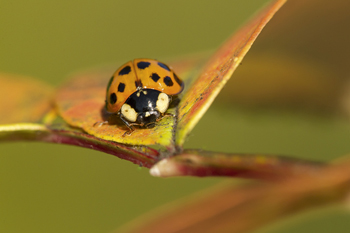Help! We are inundated with ladybirds. For the past few months we have been plagued with swarms of the insects of all different colours. We have had to keep all windows and doors shut. Why are they such a pest now rather than a pleasure?
JF, by email
The explosion in ladybirds is caused by the arrival of the harlequin ladybird (Harmonia axyridis) from Asia. Dr Helen Roy of the NERC Centre for Ecology & Hydrology says the UK Ladybird Survey is receiving many reports of large numbers of harlequins in people’s houses at the moment.
This species, which is highly invasive, is native to Asia but was introduced into mainland Europe to control pests such as aphids. It was not deliberately introduced into the UK but arrived on produce and vehicles and has spread rapidly.
Most individuals are orange in colour with black spots (numbering from zero to 21) but some are black with two or four red spots. In common with all ladybirds in the UK, it spends winter in a dormant state and begins to congregate in late autumn before moving to its winter habitat – and the harlequin likes to overwinter in buildings, which makes it conspicuous at certain times.
In 2012, harlequin numbers were slightly reduced because of the wet spring and summer. In 2013, the spring was slow to get going but the fantastic weather through July and August enabled the harlequins to increase in number. This alien species can reproduce continually during warm weather so has the advantage of producing a couple of generations per year. In contrast, many of our native species breed only once a year. So the high number of harlequins is a consequence of the good summer ie favourable weather and lots of aphids.
If they are disturbed, harlequins exude a yellow substance that can stain. The ladybirds can be treated with a residual insecticide from a pest-control company or removed through regular vacuuming.





